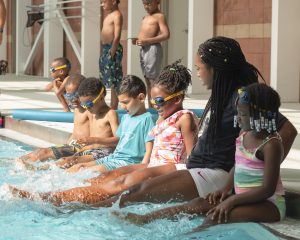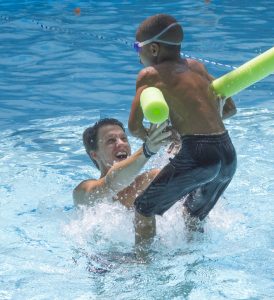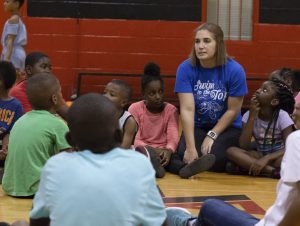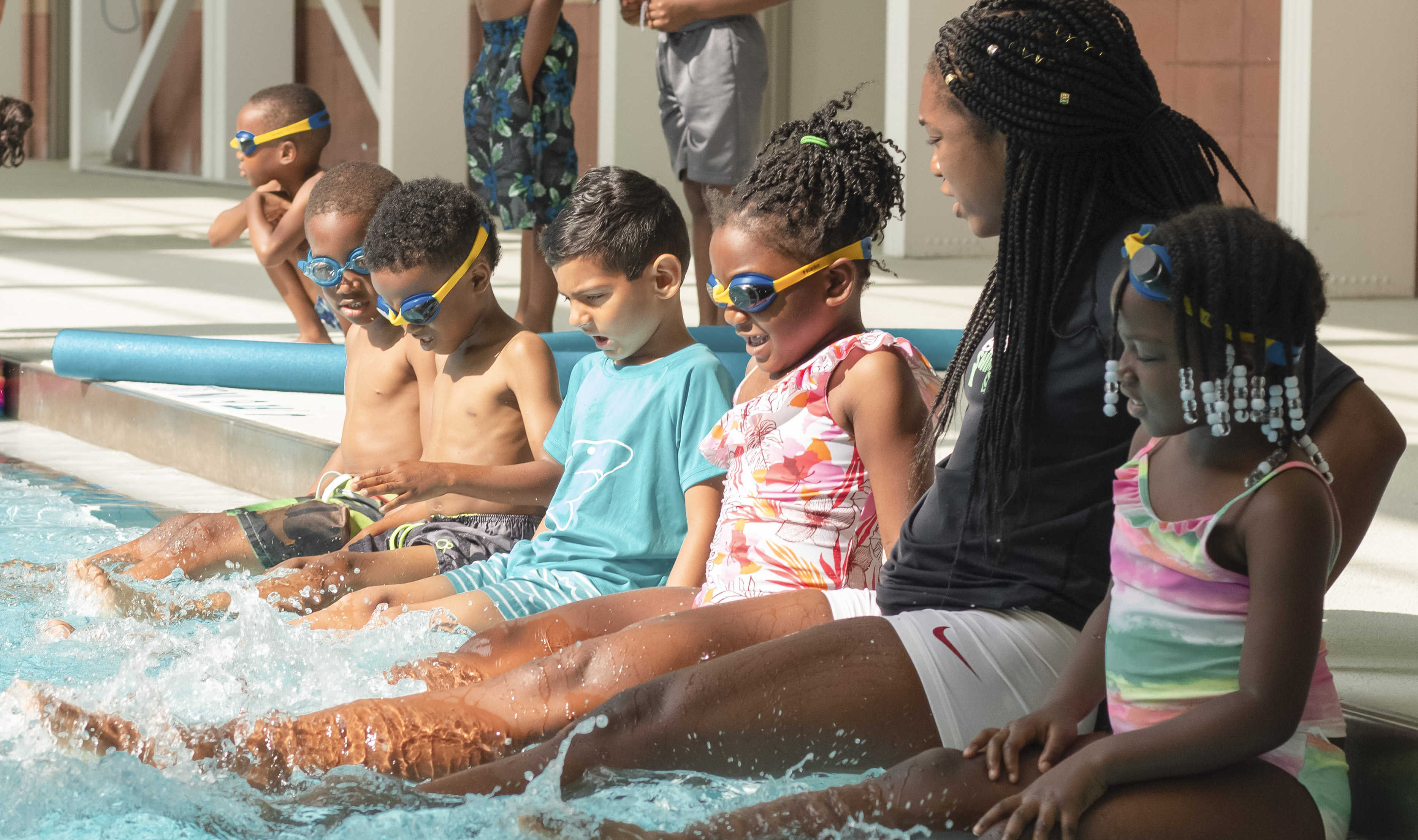Swim to The Top grows in scope, provides practicum for physical education majors

By David Miller
Kiara Williams wasn’t afraid of the pool, only the deep end.
She never strayed from the shallows on the rare occasions she’d enter a pool, like at hotels during family trips when she was a child.
“I had to get comfortable with not holding my nose and going under water,” Williams said. “I was scared.”
Williams conquered her fear of deep water, learned to swim and became certified to teach others after taking a swim instruction class at The University of Alabama.
Williams, a rising senior majoring in physical education at UA, spent the month of June teaching Tuscaloosa-area children not only to swim, but also to be unintimidated by the water.
Williams is one of a dozen UA students who served as swim instructors and enrichment teachers for Swim to The Top, an annual, month-long program that combines swim lessons, education enrichment and physical education into morning activities for children enrolled in the Benjamin Barnes YMCA Summer Camp.
“They all wanted to hold their noses when they went under water, and I was just like, ‘OK, put a bubble in your mouth and go under water real fast,’” Williams said. “I thought, ‘if they can do this, then I definitely could have done it when I was their age.’”
Williams said once she learned to swim and mastered multiple strokes, she felt like she could “accomplish anything.” Similarly, confidence and trust were gateways to learning for children in Swim to The Top.
“Most of the kids I had didn’t want to get in the water at all,” Williams said. “Once they weren’t scared of the water, anything was possible – different strokes, going under water – and they knew they could trust me.”
Logan Brashier, a senior majoring in physical education, said that while it’s easier for children to learn to swim if they begin at a young age, it’s difficult to teach them to swim unassisted in just four weeks. Like Williams, most of Brashier’s students were first-time swimmers who were afraid to enter the water.
“By the end of the four-week period, I had them floating on their own without me completely holding onto them,” Brashier said. “For four weeks, that’s pretty good, especially when they don’t know me as a person – I’m just one of their teachers. But once they begin to trust you, they learn quickly.”
A vital program

Swimming and drowning statistics underscore the importance of youth swimming programs like Swim to The Top.
According to the Centers for Disease Control, approximately 10 people drown each day in the United States, and one-fifth of fatal drowning victims are under the age of 14. The CDC also concludes that African-American children drown at a rate nearly three times higher than their Caucasian peers.
Additionally, only 13 percent of children will learn to swim if their parents cannot swim, according to the USA Swimming Foundation and the University of Memphis.
Roughly 130 children, ages 5 to 14, have participated in Swim to The Top each year since the program began five years ago. UA program coordinators estimate half of the children ages 10 to 14 who participated this year have participated since the program’s inception.
“You can look at the group of 14 year olds, and they’re all swimming in the deep end, doing full strokes and swimming full widths of the pool,” said Daniela Susnara, swim instructor and doctoral student in UA’s department of kinesiology. “That represents tremendous improvement.”
The program also offers pre and post-program swim assessments for campers based on the national Red Cross standards, which will help both instructors and parents track growth.
Swim to The Top has enhanced its community outreach across the board, from its science and nutrition education and writing activities to its water safety information for parents, said Dr. Holly Morgan, director of both Swim to The Top and community education at UA’s Center for Community Based Partnerships.
Becoming better teachers, coaches

Few, if any, UA students that taught various sections of Swim to The Top aspire to become youth swim instructors. Most hope to teach and coach other prep sports when they graduate. Still, the experiences translate into any arena of coaching or teaching, the students said.
Victoria Ivy, a doctoral student in kinesiology, taught fitness education and nutrition for Swim to The Top. Her classes required she tailor curriculum and activities to three different age groups and find creative ways to pique her students’ interests, which was challenging given the unfamiliarity with the students and the time frame, but also a helpful simulation of a classroom, she said.
“Every time I get to work with a new group of kids and get to learn new ways to incorporate games that will get them engaged and help them learn, I’m going to use that someday,” Ivy said. “I got to learn which games worked for some, which games really don’t, and I got to put that into practice in a different way than I had before.”
Brashier, who wants to coach baseball after he completes his degree, agreed that learning how to quickly connect with children that have different personalities and varying levels of interest is the foundation of a coach’s skill set. Having fun helped him connect much quicker, he said.
“[Swim to The Top] just makes me feel like a kid again,” Brashier said. “When I was their age, when I had someone let loose and be a kid, it was a whole lot more fun for me. That’s the best route to do it.”
